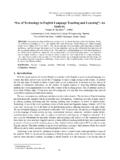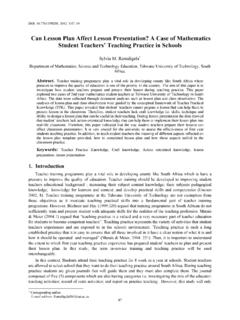Transcription of Gender Inequality in Saudi Arabia: Myth and …
1 Gender Inequality in Saudi arabia : Myth and Reality Shakir Ahmed Alsaleh+ Department of Health Informatics, School of Public Health & Health Informatics King Saud bin Abdulaziz University for Health Sciences Riyadh, Saudi arabia Abstract. For decades, Western media, scholars, and activists, have discussed the lack of equality that Saudi Arabian women face. They also think that Islam plays an important role in this kind of Inequality between men and women. This research shows that their discussions are apparently based on unreliable information gathered from people who perceive the proverbial glass as half-empty.
2 Women in Saudi arabia , like women in any country, have their perception of equality. They have a pre-eminent role not only within their families but also outside their households. The development of the Kingdom of Saudi arabia has brought with it increasing opportunities for women in education, employment, and in political participation, as will be seen in the up-coming elections for Shura Council and municipal councils. Keywords: Gender Inequality , Gender studies, equality between men and women, male and female differences.
3 1. Introduction Gender Inequality commonly revolves around three meanings: first, men usually experience better opportunities, more freedom, and higher social regard than women who share the same social characteristics (such as class origins, race, nationality, and age); second, men usually hold sway in marriages and other direct relationships between genders; and third, men occupy a preponderance of the social positions that possess significant political, economic, legal, or cultural power.
4 [14] [12] The principle of equality applies to Gender and productive rights in two main areas: relations between men and women ( Gender division) and relations among women (conditions such as class, age, nationality, or ethnicity that divide women as a group). [5] The United Nations Development Programme (UNDP) highlights some facts about Gender equality on its website. It also states that despite many improvements in the status of women, there are still many inequalities. Some of these inequalities include but are not limited to the following.
5 Two thirds of people in the world who cannot read are female Nearly seventy percent of the world s poorest people are female In only 16 countries in the world are women s representation in national parliaments above 25 percent Women s contributions to the global economy are growing rapidly, but their labor remains undervalued and undercounted in national accounts An estimated one-quarter to one-half of all women have suffered physical abuse [17] Western activists argue that women in Saudi arabia , whether at home or in the work place, are subjugated persons and that they have no say in decision making.
6 They think that moving toward achieving equality, in the home, in the workplace, and in positions of education, health and political power, remains one of the most important challenges facing the Saudi government in the twenty-first century. [13] Some western scholars and intellectuals view Islam as a major factor that determines women s condition in society. Whether or not their argument is correct, it seems that they are ignoring major factors such as social, economic, and political factors that also play major roles in women s status.
7 [22] Women in Saudi arabia , like women in any country, have their perception of equality. They play an important role not only within the family but also outside their families. The development of the Kingdom of Saudi arabia has brought with it increasing opportunities for women in various disciplines. + Corresponding author. Tel.: + (966)500525000; fax: +(966)14605656. E-mail address: 1232. Gender Inequality : Definition and Background The concept of Gender Inequality emerged during the 1980s, and by the mid-90s, a number of international conferences had been held to discuss Gender equality in developing countries in all fields in general, and in healthcare organizations in particular.
8 In June 2000, representatives from 180 countries met at the United Nations, and confirmed the centrality of Gender equality and sustainable development in advancing women s health worldwide. [25] Gender Inequality refers to the unequal valuing of the roles of women and men. [11] Thus, Gender equality can be defined as, equal treatment of women and men in laws and policies, and equal access to resources and services within families, communities and society at large. [26] To achieve equality, it means that the different behaviours, aspirations and needs of women and men are considered, valued and favored equally.
9 It does not mean that women and men have to become the same, but that their rights, responsibilities and opportunities will not depend on whether they are born male or female. [18] Moreover, Gender Inequality has many implications for people s lives, but one of the most consequential is that it acts as a basis for bias between persons. According to Ridgeway, a system of Gender Inequality persists in many countries, including Saudi arabia , despite major reforms in the way that Gender has been entwined in various economic and social organizations.
10 [19] Byrne argues that the educational system is responsible for women s subordinate status. She believes that girls are encouraged to study languages, secretarial skills, and arts, while boys are directed toward engineering, physics, mathematics, military studies, or chemistry. She contends that different qualifications mean different opportunities in work, which lead, either by force or by system, to Gender Inequality . [4] Western scholars also contend that in some societies, girls are educated as often or to the same extent as boys, so women on average are less qualified to hold jobs requiring education.










